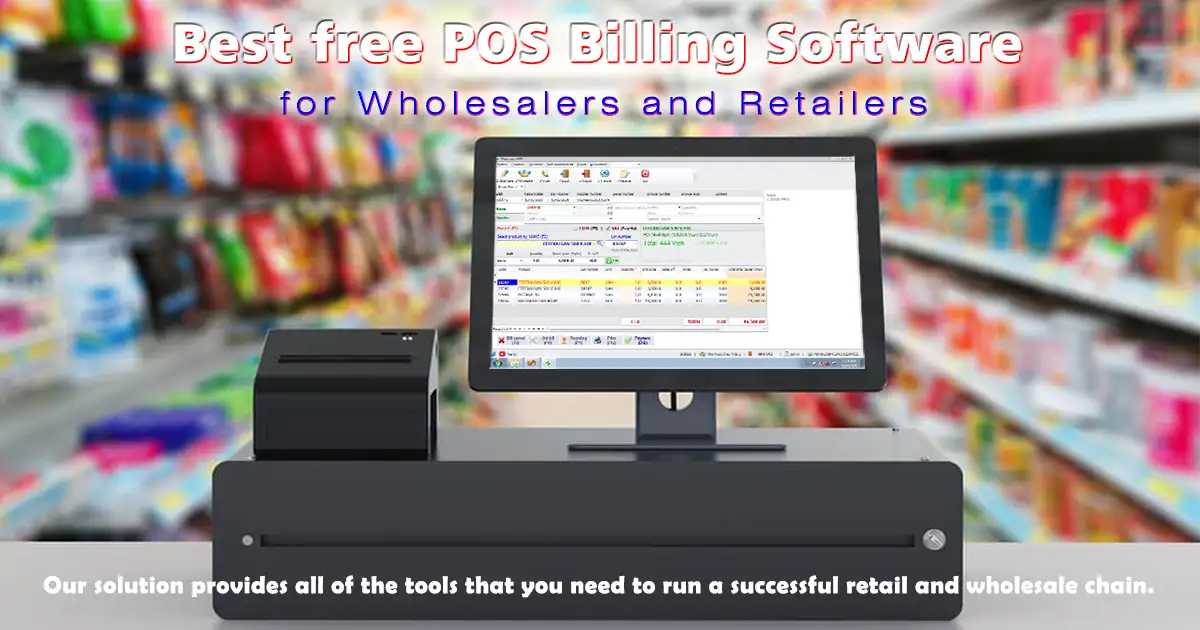
Table of Contents
- 1 Online vs Offline Store: Which One is For You?
- 2 Advantages of online stores
- 2.1 1. Easy to run
- 2.2 2. Lower setup and operational costs
- 2.3 3. The capital required is not too large
- 2.4 4. Wider market reach
- 2.5 5. Doesn’t need a place
- 2.6 6. Requires fewer employees
- 2.7 7. Availability of online shops – Open 365 x 24 x 7
- 2.8 8. Collect customer data
- 2.9 9. Look more prominent than you are
- 2.10 10. Convenience
- 2.11 11. Easily compare prices
- 2.12 12. Online tracking
- 2.13 13. Saves money
- 2.14 14. Saves time
- 2.15 15. Products sold vary
- 2.16 16. Shop safely and avoid crowds
- 2.17 17. Secure payment*
- 3 Disadvantages of online stores
- 4 Advantages of offline stores
- 4.1 1. Some businesses are more viable with the offline model
- 4.2 2. High confidence
- 4.3 3. Touch and examine
- 4.4 4. Establish a personal touch
- 4.5 5. Easier customer service
- 4.6 6. Sales Assistance
- 4.7 7. Instant purchase – No waiting period
- 4.8 8. Don’t bother shipping
- 4.9 9. Return – Replace
- 4.10 10. More secure payment system
- 5 Disadvantages of offline stores
- 6 Online, Offline, or Both
- 7 O2O Business: Combine online store and offline store
- 8 Benefits of O2O business (Combine online store and offline store)
- 9 Why is online expansion necessary for store owners?
- 10 The importance of physical stores
- 11 Hybrid commerce: How to successfully combine online store and offline store
- 12 So, what do Website and Sivib POS Software have anything to do with this?
- 13 To summarize
Hybrid commerce: Combine online store and offline store
What does Sivib POS Software have anything to do with this?
Online vs Offline Store: Which One is For You?
- Talking about offline and online stores today is quite interesting. This is because of the change in people’s consumption patterns that make the existence of offline and online stores often discussed. With the growth in online shopping, one wonders if it still makes sense to put up a retail store.
- While the trend in online shopping continues to grow, it doesn’t mean that retail store shopping is dead. The truth of the matter is that a huge number of consumers shop both online and offline. A good example is Black Friday, which shares its sales with its online counterpart, Cyber Monday. In fact, more than 80% of retail sales are projected to still happen within physical stores.
- Both have advantages and disadvantages that make consumers sometimes confused when to choose to shop where. This is not just the case with consumers. As a business, you may still be unable to decide whether to open an offline or online store to keep your business growing. If you are still confused in making choices, perhaps an explanation of the advantages and disadvantages of the two types of stores below can be considered. At the end of this article, you will be able to decide which type of store will be the better choice for you.
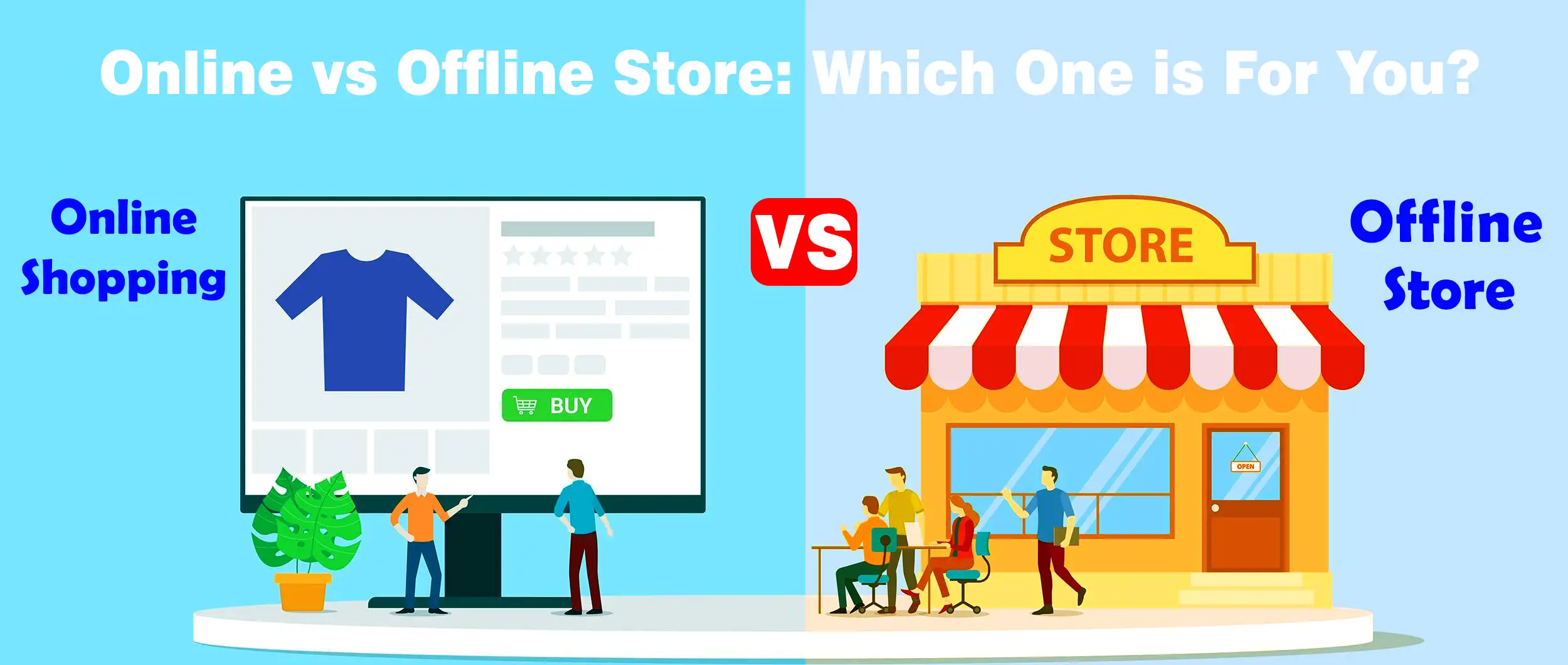
Advantages of online stores
1. Easy to run
- With the development of the internet world, nowadays it is very easy to open an online store. Simply by creating a website or an account on social media or various marketplaces, online stores can already be opened. Anyone has the opportunity to sell online, whether teenagers, homemakers, or even now, many small children who have started a business in cyberspace.
2. Lower setup and operational costs
- The main advantage of an online store is its low-cost structure. You do not have to invest in costly retail space or hire store personnel, which reduces operating costs. An online store is much easier to set up compared to a physical store. An online ecosystem enables you to create an eStore with no investment and hardly any technical expertise to get going. Setting up a brick-and-mortar store is comparatively more time-consuming and expensive as one has to identify, lease/rent/build, and set up the store. Moreover, the overheads in a physical store are higher.
- A lean cost structure provides more flexibility if there is a sudden decline in the market, much like we are witnessing today. Several traditional businesses (such as bookstores) have become unprofitable because they cannot compete with their online counterparts’ low-cost structure.
3. The capital required is not too large
- Online stores can be formed only with mobile phones and internet quota. Now, there is a reseller and dropship system that will make it easier to start a business even without capital. The reseller system makes it easy for people who want to sell something but have not been able to produce their own. Reseller actors will stock items such as shops in general. But the stock of goods for online resellers is less and is only used as an example.
- If lucky to get an agent who is in one area, the owner of an online store does not need to stock at all. Simply pick up the product when there are consumers who have ordered only. In addition to resellers, there is a dropship system that makes it even easier. On the dropship system, there is no need to stock the goods and do the delivery of the product. A drop shipper simply does promotional and marketing activities only. The provision and delivery of the product will then be handled by the agent who owns the product. This system is easier and requires less capital, but the profit earned is also not very large.
4. Wider market reach
- One of the main advantages of having an online business is that you break geographical boundaries. The vast reach of the internet world certainly has an effect with online businesses. You do not depend on the number of people passing through your street. It is certainly worth broadening your customer base to include people outside of the local area. From the internet, you can sell to the world.
5. Doesn’t need a place
- An online store does not require a physical place to accommodate any kind of product and is a place of transaction. Social media accounts and stores in various marketplaces that have been created are a place to conduct the buying and selling process. These shops can be controlled from anywhere, whether you’re on the go or at home.
6. Requires fewer employees
- Because of the simpler system, online store owners don’t have to spend a lot of time and money recruiting employees. The slaughter and delivery of goods can usually be done by one or two people only. However, if your online business grows very rapidly and gets significant orders, you might consider hiring multiple employees to make your work easier.
7. Availability of online shops – Open 365 x 24 x 7
- A significant advantage of an online store is that it can operate 365 days a year, 24×7, sales can be made at any time, and customers can buy when it suits them.
8. Collect customer data
- It’s easier to analyse customers’ buying behaviour online. Demographic data like age, gender, and other search-related behaviour can be easily ascertained with Analytics. This data greatly helps to improve the online store, products and overall. Tracking this level of data in a physical store is not possible.
9. Look more prominent than you are
- A well-designed online store gives the impression of a much larger business for small firms when compared to a physical shop. This goes a long way in establishing trust, credibility, and a loyal customer base.
10. Convenience
- Online shopping, lets you purchase items from the comfort of your home or office. Buying electronically also makes it easy for a customer to cancel transactions.
11. Easily compare prices
- Online stores display a whole range of products they offer in order to cater to different customers with different tastes and needs. This feature allows customers to make price comparisons of the different products on display.
12. Online tracking
- In an online shopping store, you can easily track the order status and delivery status of the product you purchased.
13. Saves money
- As a way of attracting customers to shop online, most online shops offer discounts to customers. They can afford to do this because they do not have to worry about maintenance and real estate costs.
14. Saves time
- When buying online, you do not have to stand in line to pay for the products you purchased. You can do it in the comfort of your home or office, so you save travel time. Likewise, you can easily search for products by entering keywords on a search engine.
15. Products sold vary
- This is the reason why many consumers flock to shop online. The items provided vary. This also applies to shop owners. Many prefer to sell online because it can provide any item from any agent as long as it is in demand by consumers.
16. Shop safely and avoid crowds
- When social distancing is becoming the norm, online shopping scores big compared to crowded offline stores. An online store allows you to shop from your home’s convenience and avoid large crowds and traffic.
17. Secure payment*
- Online stores accept all sorts of, including credit/debit cards, digital wallets, and some even allow you to pay later. These payment methods are all safe and secure, and convenient.
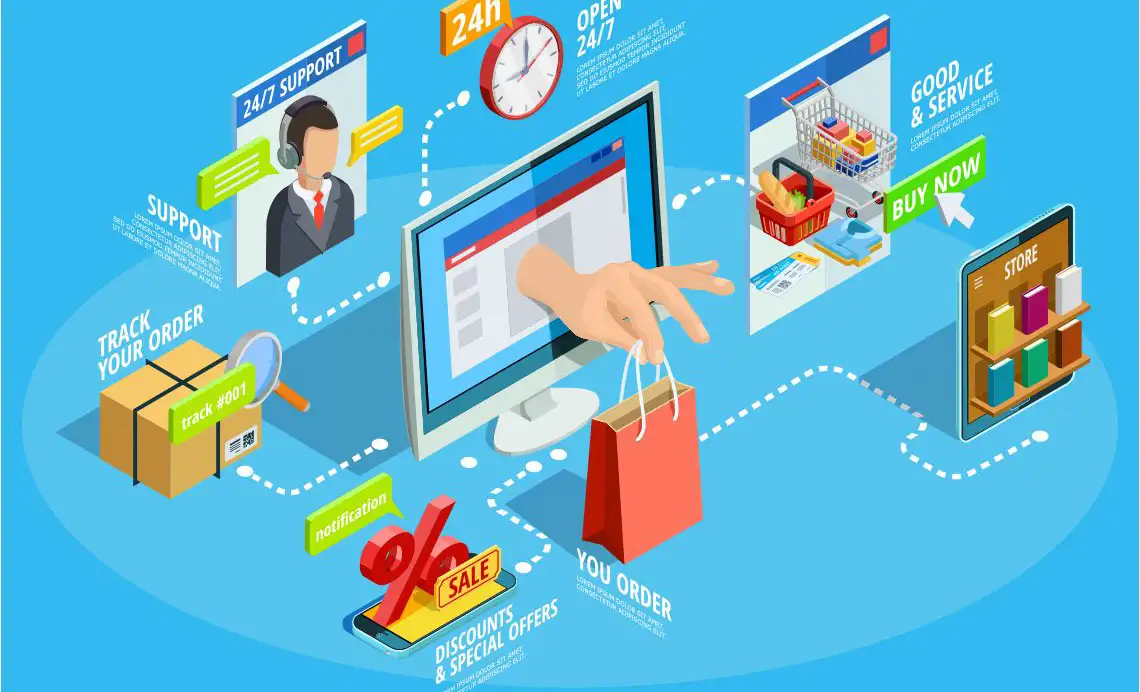
Disadvantages of online stores
Online shopping also has its own share of disadvantages though too.
1. Delay in delivery
- Delivery of the item may take from 1-3 weeks, which can be frustrating to the customer and can be one of the things that can keep them from shopping online.
2. Lack of touch and feel of merchandise
- Lack of touch and feel of the merchandise is one of the major concerns of online shoppers. You cannot buy clothes from online shops because you cannot try them on. 56% of online shoppers say they still appreciate the in-person experience over digital retailers.
- Buyers like to visit physical stores and like to examine the merchandise before making a purchase. The picture in an online shop may be different from the actual merchandise.
3. Lack of interactivity in online shopping
- In offline shopping, it would be easier for the seller to negotiate prices with buyers. Showroom sales attendants provide personal attention to customers and help them in purchasing goods.
4. Lack of shopping experience
- The experience of a showroom atmosphere cannot be replicated by online shopping websites. It is more fun to shop with friends and family. Shopping with them can be a worthwhile shopping experience.
5. Fraud in online shopping
- Online stores are subject to fraud because the payment method is not as secure as paying in person. The customer’s credit card details and bank information have been misused, which can raise some privacy issues. You need to be careful in revealing their personal information.
Offline Shopping: The consumer visits and purchases goods from the shop. While shopping online continues to be popular, some people still prefer offline shopping.
Advantages of offline stores
Here are the advantages of offline shopping to help you decide whether it is right for your business
1. Some businesses are more viable with the offline model
- For many businesses, the offline model is the only viable option. For example, even though a restaurant can advertise online, the actual dining experience is offline. Similarly, a car dealership is not likely to be as effective without its sales staff walking buyers by selecting cars and even offering a test drive option.
2. High confidence
- Offline businesses have physical stores where consumers can instantly see the products offered. Consumers can choose their own desired model, try with the appropriate size and know the quality of the materials used. Another problem that often occurs in purchases other than in online stores is color. Often the colors seen in product photos are different from the original. By shopping directly in the store, consumers will get a product that matches the desired color. Hands-on experience with products is the reason why consumers have high trust in offline stores.
3. Touch and examine
- In a physical store, you get to touch and examine a variety of choices and buy the one that you like most. For many, getting to feel the product they will be buying is almost essential. It also allows you to inspect the products closely for any well-hidden damages or defects. In the case of clothes, physical stores will enable you to try out clothes for size and fitting. You can easily switch to a different size if the apparel does not fit you, which is a big advantage.
4. Establish a personal touch
- A significant advantage of an offline store is the opportunity for customers to establish personal connections with your business. As you can speak to your customers, it is also an opportunity to upsell other items.
5. Easier customer service
- With a physical store, service to consumers can be done easily. Consumer demands will not be protracted because they can be resolved directly. Store owners can directly provide sample products, answer consumer questions, respond to complaints and make returns if needed.
6. Sales Assistance
- Imagine you just searched the entire store and found two very different, but equally great items and can’t decide which to pick. Or you are looking for a particular item that you need help locating. The in-house sales assistants can tell you about each item and help you make an informed decision.
7. Instant purchase – No waiting period
- Unlike an online store, you don’t have to wait for days to get the product when you purchase it in an offline store. You choose the product you like, make the payment, and take it home. With offline shopping, you get instant gratification.
8. Don’t bother shipping
- Because the selected product is handed over to the consumer directly after paying, the shop owner does not have to bother making deliveries. Consumers also do not have to worry when the goods that have been ordered arrive and do not have to think about shipping costs that are usually greater than the cost of transportation to the store.
9. Return – Replace
- If you’re not satisfied with your purchase, you can always go back to the store to get a replacement or refund. No more waiting 3-5 business days for the amount to appear as a credit in your next billing statement.
10. More secure payment system
- Consumers who visit offline stores will usually pay for their groceries in cash. These direct payments make offline store transactions more secure. The money to pay can be directly seen and calculated by the shop owner. In addition, there is no need to worry about payment failures and fraud.

Disadvantages of offline stores
Here are the cons of offline shopping:
1. Limited market reach
- Offline stores are not dynamic and usually only in one place. This leads to fewer market reach for offline stores. Consumers usually come from the area around the store only. This can depress sales figures if the store owner does not have a specific strategy to control the consumer area. Shop owners should also choose a strategic location to be reachable by more consumers.
2. Requires a physical place
- Since the offline store base is a real area, it takes place to accommodate all the products marketed. In addition to providing a place, of course, other maintenance is needed so that the building used can last for a long time. Shop owners should also pay attention to the order of goods sold visually to attract the attention of customers.
3. Requires more employees
- The number of activities and tasks that must be done to advance the store, it takes more employees as well. As a shop owner, you have to take the time and money to do the hiring. Although only small stores, recruitment should be done seriously in order to get reliable human resources and willing to work together to grow the business.
4. More capital
- With the various needs that have been mentioned, of course offline stores require greater capital. Starting from providing products physically, places, place maintenance costs, recruitment of employees as well as employees themselves. Make sure you have enough capital to meet some of these things before deciding to open an offline store.
5. Limited products and difficulty searching for goods
- One of the biggest drawbacks of offline shopping is the lack of choices. Due to limited space and stock restrictions to reduce losses, usually products available in offline stores are limited. If the consumer does not get the desired product, it will be difficult to find the same item or replacement directly. Consumers should look to another branch or move to a different store. With online shopping, you can choose from a wide array of apparel.
6. Time Consuming
- In offline shopping, you need to personally visit the store in order to buy products. On the other hand, online shopping can be done with just a few clicks of the mouse. If you want to save time and want to get products in the most convenient way, you are better off shopping online.
7. More Expensive
- Online shopping websites run discounts frequently and most of the time the rates being offered are extremely low. If you like discounts and cash back, then you are better off shopping online.
8. Limited sales time
- Offline stores have their own uptime. Offline stores usually operate 10 – 12 hours a day. And all trade transactions can only be done within that time period. The rest of the store is closed and does not serve customers.
Online, Offline, or Both
- As to the question of, Which is the best option for you? The answer is both.
- There is no better option because you can go online to supplement your offline business. It is true that online sales are growing and accounting for 20% of retail sales. However, the figure also means that 4/5 of purchases still take place offline. The truth of the matter is that you do not have to choose at all. There has been a recent trend of traditional retailers opening e-Commerce stores and online stores investing in physical locations.
- Recently, Amazon’s acquisition of Whole Foods also shocked the world, signaling it’s extending footprint into offline sales channels.
O2O Business: Combine online store and offline store
- This is a new business model in which retailers use both online and offline channels as an intensive strategy.
- Using online marketing and advertising, retailers find potential customers online. Their awareness of products and services raises, and as the result, they make purchases in brick-and-mortar stores.
- A popular example of this: When a customer receives an email offering a discount code, then visits the store to use this code and make a purchase.
- In the context of online channels expanding their popularity, but becoming complements of physical stores instead of competitors.
- Starting an online sales channel, for example, store owners gain a bigger customer pool.
- Turns out: Retailers can reach more customers than those who would ever come across their doors. Moreover, those customers are identified online based on their profile and favor, which helps generate more potential customers than traditional marketing.
- Other benefits of having a website have been recognized by store owners, which incentivizes them to start an O2O business.
Benefits of O2O business (Combine online store and offline store)
- The first and most important benefit that O2O brings out to retailers is the brand reputation.
- Branding is much simpler and more efficient with online capabilities like advertising, social media, mobile wallet, SMS, mobile app, push messages, and proximity services, combined with real-time data analytics, system integration, and AI.
- Here’s an example:
- A man goes online and searches for a gift for his girlfriend on Christmas Eve.
- Right in an article giving recommendations for Christmas gifts, he can see a picture of a Christmas set from a cosmetics brand.
- If the man clicks on the picture, he is showing his interest in the products and consequently becomes a potential customer of that brand.
- Those kinds of marketing tactics these days help create the brands, products, or services awareness with less time and money spent.
- Another key factor in the success of the O2O business is that it enhances customers’ loyalty and increases revenue at the same time.
What’s the bottom line?
- During their shopping journey, customers are provided with online and offline benefits that they can’t resist.
- With all the information about the brands, products, or services available online, customers can make quicker and smarter decisions on what they’re gonna buy.
- Moreover, purchasing is much more convenient and personalized, making customers feel it’s enjoyable to buy something.
- O2O commerce also lets retailers build up a database of customers’ information, including their name, age, address, interests, and even shopping behavior. It then improves the customer engagement strategy of the brands, leading to a higher level of customer loyalty.
- Once a company earns engagement from customers, it will see a dramatic increase in revenue, both short-term and long-term.
- When used effectively with an advanced POS system equipped with complex reward point features, retailers can also freely exploit and develop the built database of customers.
- One more benefit of O2O retail is that this strategy accelerates your speed to market by minimizing the time to market.
- Collecting customers’ interests and shopping behavior online, O2O helps reduce the length of time it takes for a product to be conceived until it is available for sale.
- For example, Online channels can let a fashion brand know which items, colors, or styles are the most searched, helping them anticipate the demands of customers and avoid out-of-stock status.
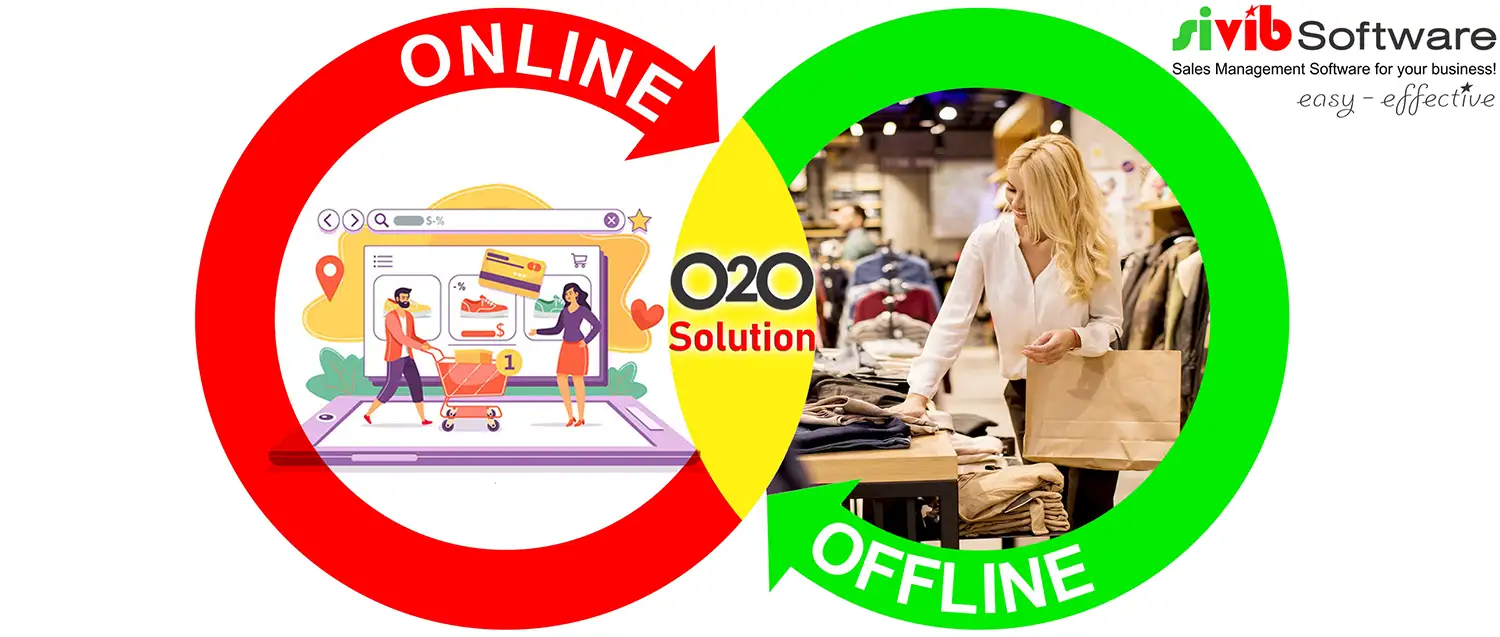
Why is online expansion necessary for store owners?
- Retailers realize that the integration of online and offline channels brings out much higher revenue than one channel stands alone. For store owners, online expansion is inevitable to improve their business in the age of digitalization.
- First and foremost, online channels make collecting lead and customers’ data for marketing purposes much easier and more effective.
- Most of the time, customers who make purchases at physical stores leave with no or little personal information gathered.
- It always takes time for store staff to collect very detailed information after purchase, not to mention prospective customers who leave without buying anything and will be left unreported.
- On the other hand: Gathering customers’ data is much more effective since customers do it on their own time on your website.
- With visitors who don’t buy any items for the first time, information can still be collected and converted into leads to be nurtured.
- With a rich database of customers, retailers can use marketing methods, like email marketing, to convert leads to customers or enhance customers’ engagement with their business.
Online channels help retailers reach new prospective customers when they use search engines.
- The possibility that someone finds your online store through search engines is much higher than their walking across your front store.
- Especially in the “Internet of Things” era, when half of the global population owns a smartphone, shoppers are searching for products online before buying anything daily.
- Therefore, selling in physical stores will only miss out on many potential customers and lessen the revenue.
- Another factor that makes a website important to the retailer is that it allows customers to shop where and when they are and in the way they prefer.
- Online channels make your business available 24/7 for customers: They don’t have to wait until 8 AM the following day to buy a dress that they fall in love with or rush after working hours to queue up for lipstick.
- Moreover, customers are empowered to choose a method of payment and shipping, which makes purchasing more enjoyable.
- Again, with an omnichannel point of sale system, retailers can have the best of both world systems syncing, streamlining both offline and online business.
- This system offers in-store cash payment or payment booths for simpler payment methods and free shipping, in-store pickup, pickup location, or a center for online sales for more convenient delivery.
- Last but not least, customers will be served more professionally with online customer support.
- Online methods allow retailers to communicate better with customers.
Here’s why:
- They segment customers into different groups based on personalized information.
- Customers will get information and services that are designed to target them.
- This brings about more effective support while at the same time avoiding wasted time and money on unnecessary service.
- Furthermore, online channels will increase the visibility of store promotions and make them available to every customer just by email or a push message.
- Customers will have various ways to access the promotion program rather than only being informed about them when they are in the store.
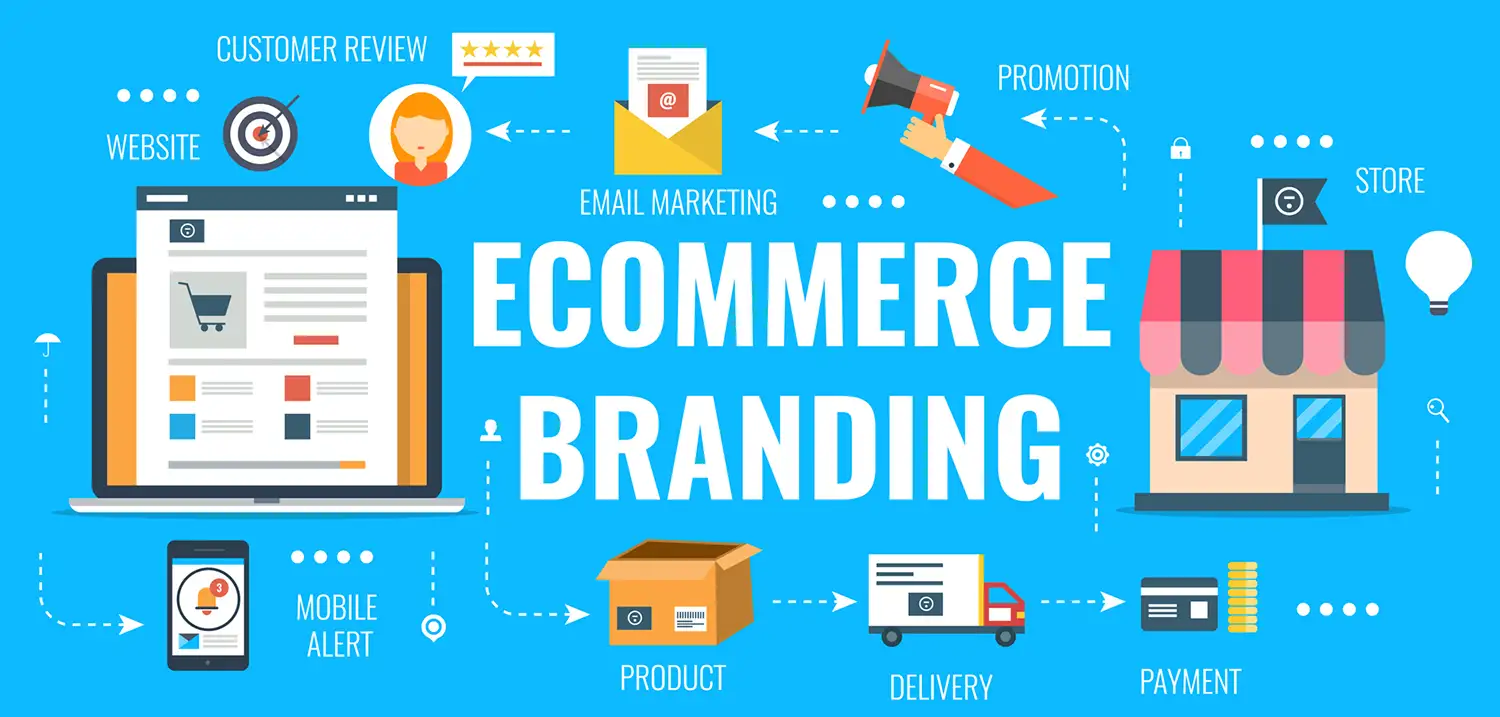
The importance of physical stores
- Although e-commerce may have introduced a breakthrough in online retail, but more than 80% of purchasing is still happening in brick-and-mortar stores.
- This is because no convenience can replace the feeling of trust and satisfaction when a customer can see directly and touch a product.
- In some product lines like fashion and accessories, for example, shoppers still prefer buying items in-store rather than online. Why?
- They want to touch, feel and try them on.
- Though shoppers are in a habit of searching for an item online before buying, it’s unsure that they place an order right on the website.
- Therefore, a physical store that customers can visit and buy things directly will build brand trust in them and make them feel more likely to come back.
Hybrid commerce: How to successfully combine online store and offline store
- Retail businesses adapt their strategies to take a hybrid approach, combining online and offline efforts to meet customers where they are and create a seamless experience across every touchpoint.
Complement offline with online
- Because of the changes in a customer’s shopping habits, integrating online retail into your offline business and vice versa becomes a necessity.
- The lines between online and offline retail are starting to blur. 85% of consumers want a unified experience across both. If you have an online store, it should be supported by an offline store. Physical stores provide customers with the experience of being able to touch and feel the products. Integrating offline and online shopping will enable you to easily track the customer journey from what to buy to the actual purchase. This will allow you to identify the touch points that occurred.
- Whether online or offline shopping, it all boils down to developing a deeper understanding of consumers and meeting their unique needs. Delivering omni-channel experiences can help empower consumer choice. It’s a matter of connecting the dots to see what will drive sales. Also, you need to understand the different online and offline factors that impact conversion rates.
- Integrating online purchases with your offline store and vice versa helps assure that you will meet customer expectations at all levels and help with customer retention. Omni-channel marketing is the way to go. Companies with omnichannel customer engagement retain on average 89% of their customers, compared to 33% for companies with weak omni-channel customer engagement.

So, what do Website and Sivib POS Software have anything to do with this?
- Back to the online and offline idea: At the very first stage, the main core of this strategy was “to find customers online and bring them to the real-world store”.
- To seek customers online, retailers use online advertising or marketing tactics such as promotion emails, social campaigns, or blog posts.
- Those methods help identify the target customers and draw them to visit your physical stores.
- To encourage online shoppers to make purchases offline, retailers need to offer them benefits. This ranges from in-store pickup to in-store cash payment, testing and fitting, free shipping, a web-returned center, a pick-up location, or a center for online sales in their actual retail stores.
Remember the role of a Good Website and Sivib POS Software?
- These combined systems will come in handy, especially when customers can check for the exact stock in real-time.
- These simple things can greatly boost your image in the eyes of your customers.
- Physical stores also create high revenue since statistics show that customers who order online and pick up in-store or exchange items in-store tend to buy extra things.
- In-store pickup seems to be one of the hottest features that e-commerce businesses offer these days, especially with the COVID pandemic.
- It allows customers to start their buying journey online and finish it offline as long as they are satisfied with the products and have a convenient shopping experience.
- Besides, in-store return is also a popular tactic for retailers since they realize that most customers find it complicated and time-consuming to send back an item via mail or courier.
- In both cases, when customers visit a brick-and-mortar store, most of them tend to buy extra things rather than their first-choice products.
- One more reason why an e-commerce business needs a physical store is that face-to-face customer service is proven to boost sales.
- Though customers can now search for information online, they’re still interested in receiving product advice from store staff: 90% of them tend to buy after receiving a reliable recommendation from staff in-store.
- Other key factors that make physical stores powerful complements of e-commerce are that they save time and money with better logistics and boost traffic to online shops.
- With the large scale of an e-commerce business, retailers must guarantee flawless operations in inventory management and order fulfillment across various localities.
- A brick-and-mortar store will serve as a warehouse and a fulfillment center, which will help retailers improve their distribution systems.
See more about Sell online on eCommerce website integrated with offline store
To summarize
- As the retail world is transforming and innovating every day, retailers must stay tuned and keep themselves updated with all the latest revolutions.
- It’s obvious that the O2O business is now one of the most popular strategies throughout the retail industry and no one wants to be an outsider in this race.
- Are you interested in getting more details about this through a free consultation?
Our solution provides all of the tools that you need to run a successful retail and wholesale chain.
Step-by-step Guide to using Sivib POS Billing Software free (Advanced)
If you have any questions about eCommerce Website Integration or suggestions for improvement to existing features. Let us know in the comment below!

